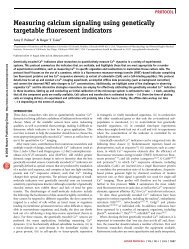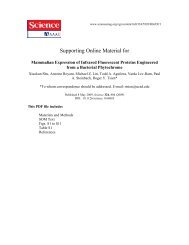THE GREEN FLUORESCENT PROTEIN - Tsien
THE GREEN FLUORESCENT PROTEIN - Tsien
THE GREEN FLUORESCENT PROTEIN - Tsien
Create successful ePaper yourself
Turn your PDF publications into a flip-book with our unique Google optimized e-Paper software.
530 TSIENTable 2Factors affecting the detectability of green fluorescent protein (GFP)Total amount of GFP (picked out by antibodies, or by position on gel if GFP is abundant enough)Number of copies of gene, duration of expressionStrength of transcriptional promotors and enhancersEfficiency of translation including Kozak sequence and codon usageAbsence of mRNA splicing, protein degradation and exportEfficiency of posttranslational fluorophore formationSolubility vs. formation of inclusion bodiesAvailability of chaperonesHindrance to folding because of unfortunate fusions to host proteinsTime, temperature, availability of O 2 , and intrinsic rate of cyclization/oxidationMolecular properties of mature GFPWavelengths of excitation and emissionExtinction coefficient and fluorescence quantum yieldSusceptibility to photoisomerization/bleachingDimerizationCompetition with noise and background signalsAutofluorescence of cells or culture media at preferred wavelengthsLocation of GFP, diffuse vs. confined to small subregions of cells or tissuesQuality of excitation and emission filters and dichroic mirrorsSensitivity, noise, and dark current of photodetectorFolding Mutations and ThermotoleranceAs mentioned previously, several mutations improve the ability of GFP to foldat temperatures above those to which the jellyfish would have been exposed.Most of them replace bulky residues with smaller ones. Their scattered locationsthroughout the three-dimensional structure of the mature protein (Figure 6)give little hint as to why they should help folding and maturation. Of course,the X-ray structures are all determined on well-folded mature proteins. Atthe stage when the mutations are needed, the protein is presumably less wellordered. As an alternative to mutating the GFP, the presence of chaperonescan also help GFP fold (68). Aside from the potential technical importanceof providing chaperones, this finding makes GFP a useful substrate for testingchaperone function (69), since GFP provides a continuous nondestructive assayfor successful folding.Requirement for O 2The requirement for O 2 to dehydrogenate the α,β bond of residue 66 (21, 23, 24)means that GFP probably cannot become fluorescent in obligate anaerobes. Sofar this is the only fundamental limitation on the range of systems in which GFPcan be expressed. Once GFP is matured, O 2 has no further effect (59). Theoxidation seems to be the slowest step (Figure 2) in the maturation of GFP (23),






